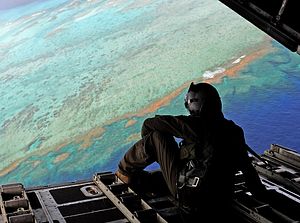The bravery and suffering of U.S. Marines at the 1944 Battle of Peleliu are deeply enshrined in the American consciousness. Less well known is how Peleliu and other Pacific islands of today’s Republic of Palau remain integral to American defense and foreign policies decades later. A few lines in the Pentagon’s 2018 budget may change that, raising awareness of Palau in D.C. just a bit closer to the level of its actual importance.
After decades as a U.S. Trust Territory, Palau gained full sovereignty in 1994, and negotiated a long-term defense agreement and Compact of Free Association (COFA) with the United States. Initial development funding expired in 2009 and although renewal of the aid, in the form of a Compact Review Agreement, was signed by each country in September 2010, it was never authorized by the U.S. Congress. In its absence, the United States has issued yearly appropriations, extending annual assistance to Palau of approximately $13 million.
Beyond the money for the remote, under-resourced, and under-developed islands, the initial COFA also delegated responsibility for Palau’s defense to the U.S. military, allowing Americans broad and exclusive base rights throughout the archipelago.
In early December, President Donald Trump signed the 2018 National Defense Authorization Act (NDAA), and, in doing so, the 2010 Compact Review Agreement between the U.S. and Palauan governments as well.
Seven years is a long time for a finalized treaty with a longtime ally and former protectorate to linger. But it wasn’t surprising. Palau, the neighboring Federated States of Micronesia, and the Republic of the Marshall Islands have long enjoyed, or endured, something like 52nd state status among the small number of U.S. lawmakers, policy wonks, bureaucrats, and officials familiar with them. They have been taken as static and glacially stable allies whose strategic location justified U.S. engagement and presence, even if only to deny that access to others. However, recent events in the Western Pacific are finally challenging the minimalist thinking about these Freely Associated States.
In July, nearly four months after North Korea conducted a series of ballistic missile tests, the United States submitted a proposal to the Palauan government to install a series of radar towers among Palau’s islands. The Air and Maritime Domain Awareness (ADA/MDA) project hopes to monitor air and maritime traffic in the vicinity of Palau. A joint statement explained, “The radar systems will provide Palau enhanced maritime law enforcement capability in its territorial waters and exclusive economic zone while also providing the United States with greater air domain awareness for aviation safety and security… as well as to the ability of the United States to maintain its defense of the Republic of Palau.”
In early October, the United States formally notified Palau of its intent to exercise its right, under the existing COFA, to use additional lands, beyond those initially designated for the radar. Collectively, these actions resulted in a joint committee meeting held in Honolulu, Hawaii in late October to work out the technical details, at which time U.S. negotiators pledged to complete the Compact renewal.
More tellingly, the 2018 NDAA also requires the secretary of defense to commission a review of U.S. security and foreign policy interests across all three Freely Associated States: Palau, Micronesia, and the Marshall Islands.
The study will examine “the role of the Compact of Free Association in promoting United States defense and foreign policy interests, including the United States defense posture and plans” and “the economic assistance practices of the People’s Republic of China in the Freely Associated States and the Pacific region.”
Chief among those “economic assistance practices” are those the People’s Republic of China (PRC) encourages and subsidizes through the increased presence of the Chinese company Exhibition and Travel Group (ETG) on the island of Yap, about 400 kilometers (250 miles) away from Palau’s northern-most island. According to reports from Yap, which is a part of the Federated States of Micronesia, ETG’s “assistance practices” there have included attempts to bribe influential people.
Yap is only 800 kilometers (500 miles) away from Guam, home of Anderson Air Force Base, the most important U.S. air base west of Hawaii. Guam may be best known as the recent target of North Korean leader Kim Jong-un’s nuclear threats. And if things weren’t complicated enough, farther to the east lies the U.S. military’s Ronald Reagan Ballistic Missile Defense Test Site, which is located in the Republic of the Marshall Islands, itself a Freely Associated State with the United States.
What exactly the U.S. military has planned in Palau, itself now brimming with Chinese tourists on subsidized vacations, remains to be seen. But clearly D.C. awareness of the Freely Associated States is nudging slowly closer toward their tremendous strategic importance to U.S. interests. Lawmakers and the president are to be commended for using the NDAA to do just that.
Scott Leis is an International Program Officer for the U.S. Federal Aviation Administration in Washington, D.C. and an officer for Habele Fund, a U.S. based non-profit whose goal is to expand the educational opportunities of Micronesians from Yap’s neighboring islands.

































